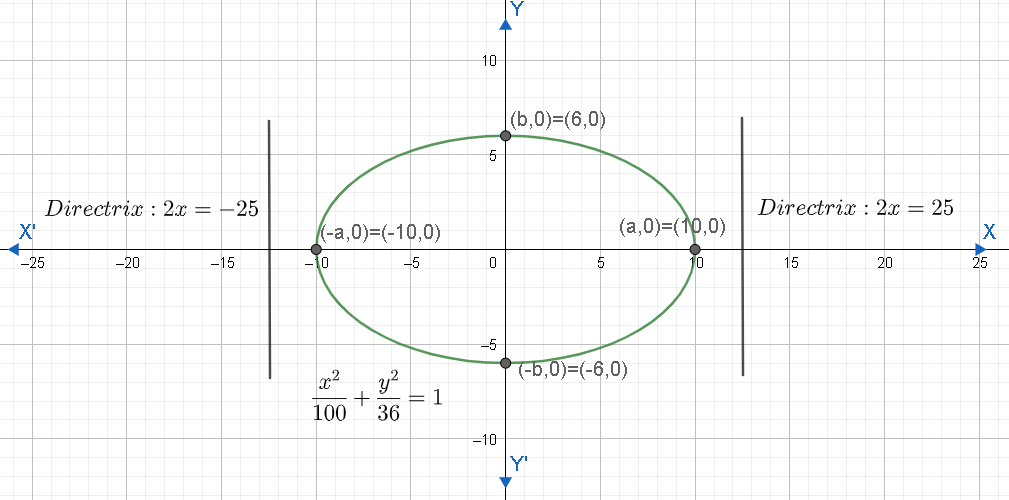Question
Question: Find the equation of the directrix of the ellipse \(\dfrac{{{x}^{2}}}{100}+\dfrac{{{y}^{2}}}{36}=1\)...
Find the equation of the directrix of the ellipse 100x2+36y2=1 .
Solution
To find the equation of the directrix of the ellipse 100x2+36y2=1 , we will compare this equation to the standard form a2x2+b2y2=1 and find a and b. Then, we have to find the eccentricity using the formula e=1−a2b2 . We can find the directrix using the formula x=±ea . We have to substitute the values and form an equation.
Complete step by step answer:
We have to find the equation of the directrix of the ellipse 100x2+36y2=1 . We know that the standard equation of an ellipse is given by a2x2+b2y2=1 , where where a and b are the length of semi-major and semi-minor axis of an ellipse. Let us compare the given equation to this standard equation. We can see that a2=100 and b2=36 .
Let us consider a2=100 . We have to take the square root of this equation.
⇒a=100⇒a=10 units
Now, let us consider b2=36 . We have to take the square root of this equation.
⇒b=36⇒b=6 units
Therefore, we found a and b.
We know that eccentricity of an ellipse is given by
e=1−a2b2
Let us substitute the values of a and b in the above equation. We will get the eccentricity of the given ellipse as
⇒e=1−10036
Let us simplify the RHS.
⇒e=100100−36⇒e=10064⇒e=10064
We know that 64=8 and 100=10 . Therefore, we can write the above equation as
⇒e=108
We have to cancel the common factor 2 from the RHS of the above equation.
⇒e=54
We know that If an ellipse has centre (0,0) ,eccentricity, e and semi-major axis, a in the x-direction, then the directrix is given by
x=±ea
Let us substitute the value of a and e in the above equation.
⇒x=±5410⇒x=±10×45⇒x=±450
Let us cancel the common factor of 2 from the RHS.
⇒x=±225
Let us take 2 from the RHS to the LHS to create an equation.
⇒2x=±25
Let us draw the graph of the given equation.

Hence, equation of the directrix of the ellipse 100x2+36y2=1 is 2x=±25 .
Note: Students must be thorough with the formulas related to the ellipse. Here, we have used the standard form a2x2+b2y2=1 , when a is along x-axis. We know that for an ellipse a>b . The largest value (a) comes along with x in the given equation 100x2+36y2=1 . If the equation was of the form 36x2+100y2=1 , we would have used the standard equation b2x2+a2y2=1 and the corresponding directrix can be found using the formula y=±eb .
